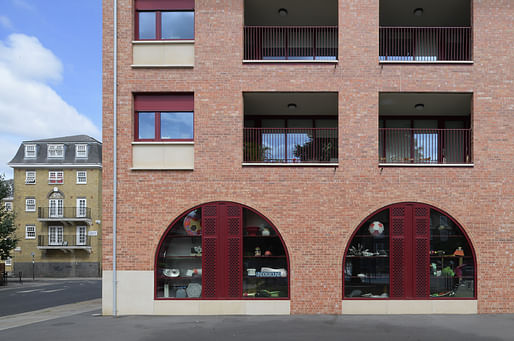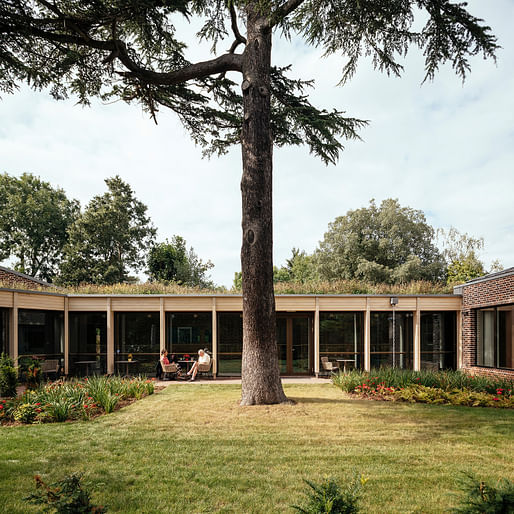
The Royal Institute of British Architects (RIBA) has just announced a six-candidate shortlist for the 2023 RIBA Stirling Prize, recognizing the best achievements in building in the country over the past year in what is now the award’s 27th edition.
The shortlist features schemes for housing, higher education, cultural connection, artists, and elder care that offer what the organization says are “genuinely inspiring solutions to our most pressing problems” while promoting, among other values, RIBA’s push for sustainable outcomes a year after the Prize was marred by critical debate surrounding the subject.
"The 2023 Stirling Prize shortlist illustrates why architecture matters to all of us. These six remarkable buildings offer thoughtful, creative responses to the really complex challenges we're facing today. Whether it's tackling loneliness, building communities, or preserving our heritage, these projects lay out bold blueprints for purposeful architecture,” RIBA's new President, Muyiwa Oki, added, speaking of each project’s tenets and social mission.
Jury members Niall McLaughlin, Mona Chalabi, Armstrong Yakubu, Rachael Owens, and Marek Suchocki all worked under the guidance of this year’s Chair, OMA Partner Ellen van Loon, to select finalists based on three in-person assessments and the architect’s ability to overcome challenges latent in the work, which was further subject to a range of different criteria.
The finalists will be presented in an exhibition held at RIBA’s 66 Portland Place headquarters gallery from September 14th onwards. The winner is set to be announced on October 19th at RIBA’s special Stirling Prize Ceremony in Manchester. Other awards will also be presented there. The full 2023 Stirling Prize shortlist can be viewed below.
A House for Artists by Apparata Architects

RIBA citation: "A House for Artists provides an ambitious model for affordable and sustainable housing. Following a six-year effort by arts organisation Create London, along with London Borough of Barking & Dagenham, Be First, and the GLA, to provide affordable accommodation for creative people, the result is a flexible live/work space for 12 artists arranged across five floors. In exchange for reduced rent, they deliver free creative programmes for the neighbourhood through a street-facing glass-walled community hall and outdoor exhibition space on the ground floor.
A sense of community permeates the design. Each set of three apartments shares a communal outdoor space inhabited by plants and personal objects, and is scaled for eating and working together, as well as access. Corridor-free internal arrangements, tall ceilings, and dual-aspect openings facilitating cross-ventilation give a feeling of generous space. Extensive glazing to the external walkway blurs the edges between inside and out to deliver a thoughtful and assured piece of architecture."
Central Somers Town Community Facilities and Housing by Adam Khan Architects


RIBA citation: "Central Somers Town Community Facilities and Housing are part of a larger masterplan commissioned by the London Borough of Camden for an extensive area within the very deprived Central London neighbourhood of Somers Town, adjacent to St Pancras station. Adam Khan Architects was assigned Plot no.10 and asked to design and supervise the construction of a flexible community children’s facility as well as that of several housing units for social rent.
These buildings have been very well received both by tenants and the wider community. The ground floor is occupied by a successful, robustly detailed post-school club for 4-11-year-olds that also welcomes parents onto its premises; and by a theatre education charity called Scene & Heard which engages 400 children. The former also has a very generous outdoor adventure playground, much appreciated by many children in the area. Internally, Douglas Fir glazed partitions are used to create functional rooms and cosy nooks, bringing intimacy and calm to the space. By incorporating a large football pitch at rooftop level, the architect was able to adhere to a challenging constraint of no loss of existing open space on the site."
Courtauld Connects, The Courtauld Institute of Art by Witherford Watson Mann Architects


RIBA citation: "The gallery occupies the central section of the Grade I-listed Somerset House, facing onto the Strand. The building was designed by William Chambers in the late 18th century as the Royal Academy and has been occupied by the Courtauld Institute since the early 1990s. On first glance, the jury struggled to understand what the architects had done, as much of it is immensely subtle.
Whilst the building’s listed status limited what could be achieved in terms of sustainability, the work included local fabric improvements, large-scale modernisation of services systems and advanced monitoring to assist with energy management. These interventions have been seamlessly integrated in most parts of the building, so as not to detract from the built heritage. Overall, the jury thought this was an extremely well-judged project, which lets the spirit of the historic building lead the visitor experience, but with some 21st-century creativity to solve some of its inherent complexities."
John Morden Centre by Mæ

Jury citation: "The brief was to bring functions from across the college into a single building. These include a medical centre, café, lounges and administrative offices. Mae’s concept was to provide a meandering timber ‘spine’ that stitches together a series of brick ‘pavilions’ housing the various care and enrichment programmes.
The building, while warm and welcoming, also appears simple, robust and well-detailed, which should allow it to mature well over time.
The project provides a delightful set of meandering spaces which expertly combine recreational and more tricky medical facilities without feeling institutional. Such stimulating spaces are vital to conquer loneliness and isolation. It is beautifully yet robustly detailed and should be a joy to use for years to come."
Lavender Hill Courtyard Housing by Sergison Bates architects

Jury citation: "The judges were impressed by the project’s success at inserting a dense development into a very constrained site. The unassuming entrance to the site opens up into a welcoming courtyard that is accessible to all units and creates a sheltered communal space and sense of privacy among the busy surroundings. Bedrooms are on the lower floor level, with windows opening onto communal or private courtyards. On the first floor, living spaces are open to daylight and views.
The construction is well executed. Attention to detail and a simple yet considered sense of materials, both internally and externally, create a different character to each apartment. Interiors have high ceilings with exposed joists, terracotta and oak floors, and glazed screens giving a homely feel that residents build upon to add their own character. New facades, meanwhile, reflect the Victorian industrial heritage of the site rather than the domestic Victorian architecture of the surrounding terraces. Units have intuitive internal layouts that allow multiple views across the site, with each apartment having a different relationship to the courtyard.
Although reuse of the existing workshop building could not deliver homes of sufficient quality, the architect engaged with circular economy principles, carefully dismantling the structure so that materials could be reused. Some of the reclaimed bricks were used to build the garden walls, and the remainder were graded and sold for reconstruction elsewhere. By choosing brick as the principal material, the new building can similarly be dismantled and reused when it reaches the end of its life."
University of Warwick Faculty of Arts by Feilden Clegg Bradley Studios

Jury citation: "The impressive new Faculty of Arts building for the University of Warwick brings together the departments and schools of the faculty under a single roof for the first time.
It is evident that this simple mission became the driving principle behind the entire scheme, to create a vehicle for collaboration and cross-pollination of the arts, while drawing inspiration from the site’s unique parkland context. The architect has woven these two agendas into one cohesive design concept that has been executed with skill and craft.
The combination of the client’s ambitions to create a new model of working for the faculty, and the architect’s creativity in articulating this ambition through a holistic design approach, has resulted in a delightful building with a series of engaging spaces that are both inviting and flexible, enabling collaboration, creativity and innovation."

Land Art Generator Initiative 2025 Fiji: Climate Resilience for Island Communities
Register/Submit by Mon, May 5, 2025

The Home of Shadows / Edition #3
Register by Wed, Jan 29, 2025
Submit by Mon, Mar 3, 2025

Hospice - Home for Terminally Ill #4
Register by Wed, Jan 15, 2025
Submit by Mon, Jun 16, 2025

MICROHOME Kingspan 2024/25
Register by Thu, Feb 13, 2025
Submit by Tue, Mar 18, 2025
No Comments